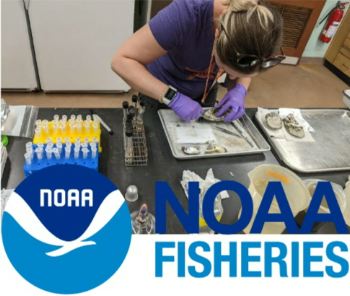|

Mariah Kachmar gives wild oysters a health check to promote Long Island Sound restoration and aquaculture
Are Restored and Natural Oyster Reefs In Long Island Sound Healthy?
 UNITED STATES
UNITED STATES
Friday, September 22, 2023, 07:00 (GMT + 9)
Mariah Kachmar gives wild oysters a health check to promote Long Island Sound restoration and aquaculture
.png) I am a shellfish health and disease technician at the Northeast Fisheries Science Center’s Milford Lab in Connecticut. My expertise is in marine disease ecology, which focuses on understanding host-pathogen-environment relationships. My position involves both field and laboratory work. Being part of all aspects of the project and learning new skills outside of my area of expertise is highly fulfilling. I am a shellfish health and disease technician at the Northeast Fisheries Science Center’s Milford Lab in Connecticut. My expertise is in marine disease ecology, which focuses on understanding host-pathogen-environment relationships. My position involves both field and laboratory work. Being part of all aspects of the project and learning new skills outside of my area of expertise is highly fulfilling.
Oysters are a vital component to the ecosystems in Long Island Sound. They provide food for our communities, improve water quality, and serve as habitat for other aquatic animals. Naturally occurring and restored oyster reefs have increased in the Sound, sparking a need to understand the condition of these populations.
Shellfish health and Disease Technician Mariah Kachmar measures an oyster with a digital caliper at Ash Creek in Fairfield, Connecticut. Credit: NOAA Fisheries/Mariah Kachmar>>>
Here at the Milford Lab, our research team is asking some big questions about Long Island Sound’s oysters:
- Are the oysters within these reefs healthy?
- Are these populations able to self sustain?
- Is anything negatively impacting reefs in the region, such as water quality or marine pathogens?
In order to answer these questions, our team has spent countless hours planning sample collections and oyster reef population surveys. The Connecticut reefs we study are intertidal, meaning that they are exposed during low tide. To access these reefs when they’re fully exposed, we schedule our visits around the expected tide schedule so our team can easily walk to them without being submerged in water. However, the New York reefs are sub-tidal, meaning that they are always underwater, making it more challenging to access them. At these sites, NOAA divers assist us
.png)
Microscope view (10x) of moderate Dermo disease that has been enlarged and stained using Ray’s Fluid Thioglycollate Medium and Lugol’s Iodine. Credit: NOAA Fisheries/Mariah Kachmar
From March through November, we visit our reef sites monthly to monitor water quality and test oysters for disease. To a degree, disease testing is like giving these oyster populations a check up. It entails sampling specific tissues from the oysters for microscopy, molecular diagnosis, histopathology, and genetics. We focus primarily on three common oyster diseases that affect oyster health and survival: Dermo, MSX, and SSO. Sampling monthly allows us to follow the cycle of these pathogens, comparable to monitoring the spread of the flu pathogen during flu season. These diseases favor warm water temperatures and progress as temperatures begin to rise in the spring and summer months. Disease can also increase at different stages of oyster reproduction, so we observe the body condition of the oysters to track their reproductive development.
I find sampling days to be some of the most interesting because the oysters from each site have clear differences that you wouldn’t notice by just glancing at a reef. Some examples include:
- the way the oysters settle to form the reef
- growth patterns
- biofouling and organisms living within the reefs
- reproductive development and age
- disease progression
We are starting to make observational connections between the environment, the oysters, and disease progression over time at each reef.
.png)
Biological Science Technician Isaiah Mayo (left) and Shellfish Health and Disease Technician Mariah Kachmar (right) measure oysters at Fence Creek in Madison, Connecticut. Credit: NOAA Fisheries/Kristen Jabanoski
We conduct a larger oyster population survey each spring and fall. So far, we completed our spring population surveys at our two Connecticut reefs in June 2023. These surveys are an enormous job. We need “all hands on deck” and recruit other members of the Milford Lab to help us complete all of our tasks when we’re out in the field—a favorite aspect of mine! These surveys create a fun bonding experience that you don’t get on a day-to-day basis. The surveys usually take several hours so we pack an abundance of snacks, sunscreen, and light layers. From personal experience, you can never pack enough! Getting sunburnt and “hangry” in the field is a recipe for disaster. We lucked out with weather during both of our completed surveys, but we did have a close call—we just missed a thunderstorm rolling in as we were packing up our field vehicle.
While we haven’t fully analyzed our data yet, we hope to learn more about these oyster populations and share valuable information with local communities, aquaculture farmers, resource managers, and scientists.
Author / Source: Mariah Kachmar / NOAA Fisheries
[email protected]
www.seafood.media
|



